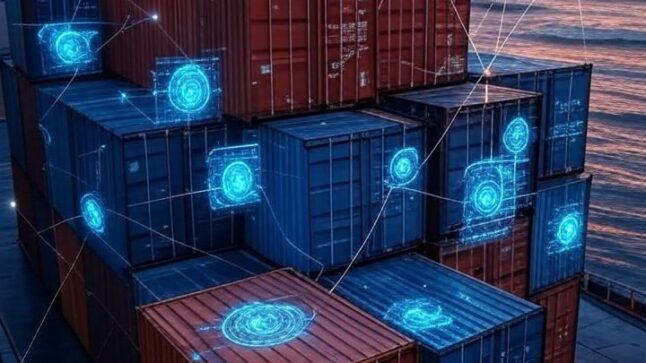Sangeet Choudary has just released a new book titled Reshuffle: Who wins when AI restacks the knowledge economy.
Sangeet is best known for co-authoring Platform Revolution with Geoffrey G. Parker and Marshall W. Van Alstyne. He has another book Platform Scale, which is quite good. These two books is why he is considered one of the best thinkers for platform strategy.
And Reshuffle is his first big work on Generative AI and what it means for businesses. It’s definitely worth reading. I would describe it more as a series of frameworks for different aspects of GenAI. It’s not really a single strategy. It strikes me as his thinking on GenAI thus far. And it has lots of little gems.
–
This article has my 4 main take-aways from the book. But this is my interpretation and thoughts, which is not the same as summarizing his thinking. Note: I did a shorter podcast version of this here.
Take-Away 1: GenAI’s Biggest Impact Will Be as a New Technology for Coordination
This is really his main point. Everyone is talking about GenAI as a tool that impacts productivity. Which it does.
But it’s the impact on coordination that will be the most important. It will enable greater coordination between individuals, teams, businesses and platform business models. And most profoundly, it will enable far greater coordination across ecosystems. In ways, we have never seen before.
This book feels a lot like a continuation of the thinking of Nobel Laureate Ronald Coase. He won the Nobel Prize for answering the question: Why do firms exist?
His answer was coordination costs. Also called transaction costs.
These are the hurdles that make interactions between parties difficult. These are frictions (or costs). Such as in marketplaces where there can be difficulties in finding a seller, overcoming information asymmetries, building trust, enabling shipments, coordinating payments and so on. Those are all coordination costs we see in buy/sell transactions.
Coase’s answer to the question of why firms exist was that they lowered coordination costs internally. He said that if the coordination costs for a transaction were low, then businesses could do transactions for goods and services out in a marketplace. If they were high, they were better done internal to a firm. So sometimes you contract lawyers and suppliers externally. Sometimes you hire in-house counsel and produce certain supplies yourself.
And that example is just for marketplace transactions. There are lots of other types of interactions between parties – such as communication, watching videos, doing group projects, finding dates, etc. They all have coordination costs that determine whether they can be done externally in an ecosystem or must be done internally in a firm.
The book Platform Revolution and especially Martin Van Allstyne argue that platform business models are in the business of lowering these coordination costs. That is their main purpose. They enable interactions to happen between different parties within an ecosystem that otherwise couldn’t happen. These platforms can also be called ecosystem orchestrators.
And here is the big idea by Sangeet. He is arguing that GenAI can enable coordination on a much broader scale that platform business models. And in ways we have never seen it before.
Platform business models are actually limited and very specific ecosystem orchestrators. They are focused on specific types of interaction that can be standardized and then scaled up. In fact, the five platforms I often talk about (marketplace, payment, coordination, innovation, learning) are all solutions for very specific types of interactions and their coordination costs.
However, it turns out these are pretty rare exceptions. Most interactions in business and in life are much messier. They can’t be standardized. They can’t be enabled by platform business models.
But Generative AI is a technology that can (in theory) enable coordination between all sorts of entities within an ecosystem. And they doesn’t have to be standardized. GenAI doesn’t require structured data. It can (in theory) enable coordination in ways never before possible.
I’ll go into this in the next point.
But the first take away is that Generative AI is about enabling coordination. You could say it is enabling fast and cheap coordination.
Which is an interesting contrast to the book Prediction Machines, which argued that AI (not GenAI) is about fast and cheap prediction.
Take-Away 2: GenAI Coordination Emerges on 3 Levels (i.e., the Shipping Container Example)
Sangeet has a good example of the standardized shipping container as a similar transformational technology.
The standardized shipping container was first commercialized by American businessman Malcolm McLean in 1956. Using a standardized steel box for shipping goods enabled seamless transport between ships, trucks, and trains. All without the need to unload the cargo. That was a huge advancement in terms of productivity.
Sangeet (who lives in Singapore) argues that you can see the impact of this new technology play out on three levels.
- It was a tool that impacted tasks. It was a productivity tool.
- It impacted organizational systems. It enabled new ways of working between parties.
- It changed the entire ecosystem.
You could also argue that it changed the positions of power and control in the ecosystem. For example, control of trade routes enabled by global shipping became a new form of power.
Here’s a better explanation of the three levels.
First, the standardized cargo container had a big impact on the productivity of ports and shipping.
You no longer had to unload and reload the goods at every point of transfer. The boxes could = just be moved between ships, trains, trucks, etc. It was much faster. And it later enabled port automation. Shipping goods could now happen at much greater speed and volume. And it was more reliable.
Second, it enabled coordination.
The shipping container enabled a more standardized system that aligned the actions of lots of independent actors. The previously uncoordinated and unreliable system meant all the actors had to keep big inventories everywhere. Because you couldn’t really count on shipping. They also needed higher insurance cost. And the overall higher inefficiency cost them in lost revenue. Prior to the improved coordination, the only way to get more efficient was to vertically integrate.
But now a new type of coordination emerged. There were standardized volumes. There were standardized contracts. There was digital tracking. It all became predictable. And big investment poured in.
Sangeet gives some other examples of this type of increased coordination enabled by a new technology.
- Airbnb, a platform business model, did the same thing for housing. It created a standard. It enabled transactions between homeowners and renters.
- Stripe did the same thing for payment, with a platform business model and APIs.
- Walmart and Shein created greater coordination with the many suppliers in their supply chains.
Finally, the shipping container changed the ecosystem. It enabled global trade, which was a reshuffling of the ecosystem.
Suddenly, big MNCs didn’t have to vertically integrate to operate across multiple countries. Anyone could access different geographies for sourcing or for selling. It dramatically opened up global trade and other cross-border shipments for all types of firms. And we saw an explosion of modular innovation.
The key take-away here is that this new first had an impact first as a tool. It impacted tasks. But the second order effects were much greater. It created a cascade of changes across the organizations and the ecosystem.
Take-Away 3: GenAI is Dramatically Increasing What Can Be Coordinated (i.e., the OTA and Construction Examples)
The previous example was for a physical shipping network. But we can see similar examples in supply chain management. And in digital platforms, like marketplaces. All are examples of technology increasing coordination and reshuffling ecosystems.
So how is GenAI different as a coordination technology?
All the mentioned coordinating activities require a standardization of inputs. And you need structured data. You need everyone putting their listings on Airbnb in the same formats. You need everyone putting their goods in the same size containers. Both standardization and structured data are key. Then you can do repeated transactions or other interactions at large scale.
And to get sufficient standardization across the parties in the ecosystem, you need:
- Consensus among all the parties (like with the adoption of shipping containers).
- A large player mandating it on everyone else (like Walmart telling suppliers what to do).
- A platform business model serving as a governance function.
But GenAI doesn’t appear to need any of these things to coordinate activity.
- GenAI is ok with unstructured data. It can watch videos. It can read emails.
- GenAI can access tacit knowledge and information. It can listen to conversations and meetings and pull out the key points.
- It can coordinate in non-standardized formats. Like humans, it can flip between various systems. Like humans it can flip between browser tabs and paste information from one system to the next.
The example Sangeet uses for this is online travel agencies (OTA), like Expedia. These are marketplaces for tourism and travel services. And they have long struggled to move beyond just basic hotel or flight bookings. For lots of reasons:
- Hotels and residences can include lots of formats. Nice hotels vs. regular houses. Rural locations versus urban setting. The supply side is not exactly standardized as inputs.
- There is lots of ambiguity in assessing and choosing hotels. The buyer usually has to read through tons of reviews. It takes a lot of time.
- You can’t easily coordinate hotel bookings with other parts of your trip. What about taxis, food, trains, airlines, experiences? You basically have to flip between different browser tabs and do it manually for each product / service.
- Plus, there is a lot of translation needed. International travelers and merchants are often operating in different languages. That makes standardization harder.
But GenAI can coordinate all of this.
You can tell GenAI about your trip and it can look at all the housing types. It can read all the reviews for housing options. It can ask you about transportation. It can ask what kind of food you like. And then it can bounce between the different online services (like flipping between tabs on the browser) and it can plan the whole trip in a coordinated fashion.
GenAI can do what the existing digital platforms and tools cannot. It can successfully coordinate across fragmented ecosystems at scale. Without standardization. Without mandating clean inputs and structured data.
It turns out that the platforms and other standardizable ecosystems we use are a small subset of economic activities. There are lots of other types of potential interactions that are not standardizable. And that are based on unstructured data and tacit knowledge. And that is what GenAI is, in theory, capable of coordinating.
Here are my standard graphics for the differences between traditional businesses (i.e., pipelines) and platforms (ecosystem orchestrators). This is how I usually explain to students what a platform (i.e., ecosystem orchestrator) is doing.
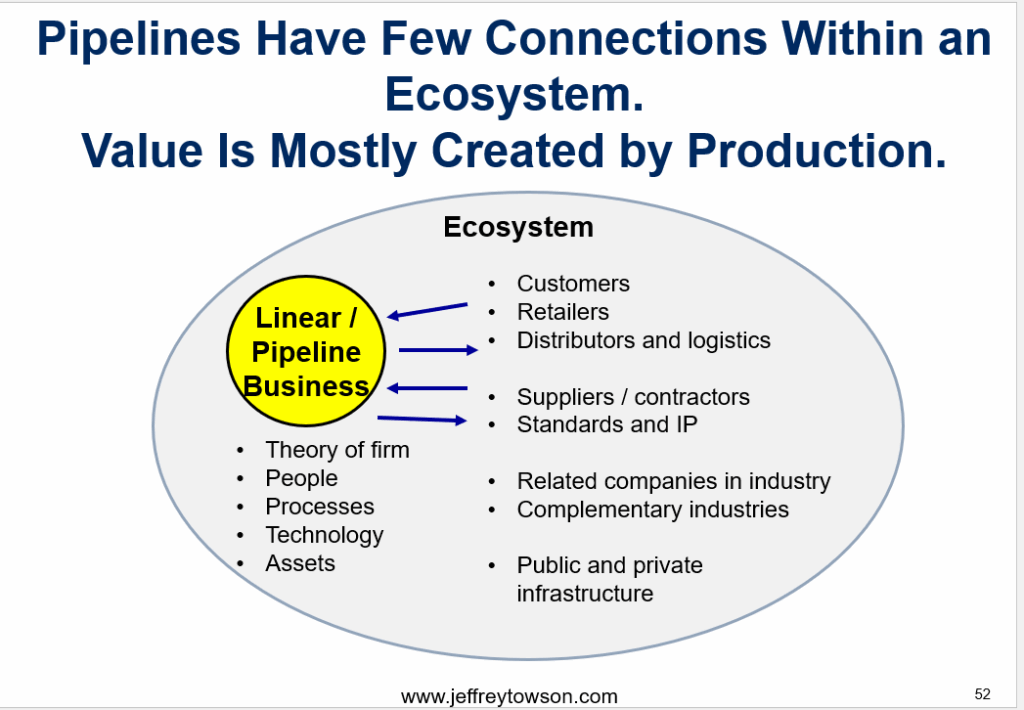
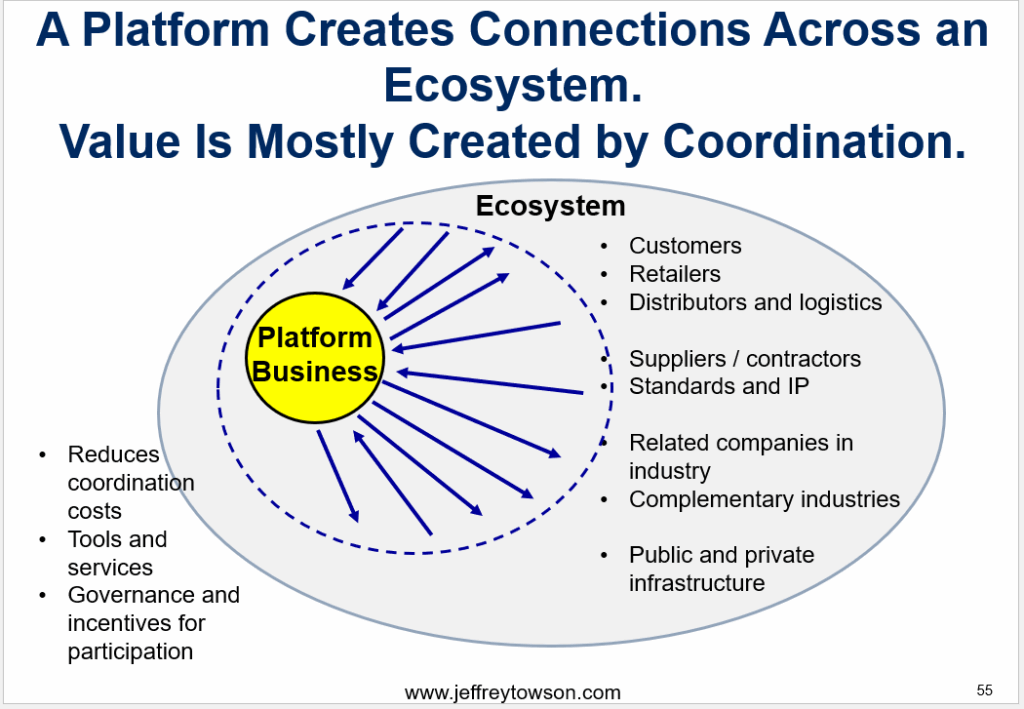
But now I think this second graphic is not the whole picture. Platforms may turn out to be a narrow subset of what is possible in terms of ecosystem coordination.
The above graphic could be a description of a platform business model in tourism. Like Expedia. But under the OTA example I just described that graphic should look like this. With the various platforms shown being Expedia, Booking, Viator, Uber and others.
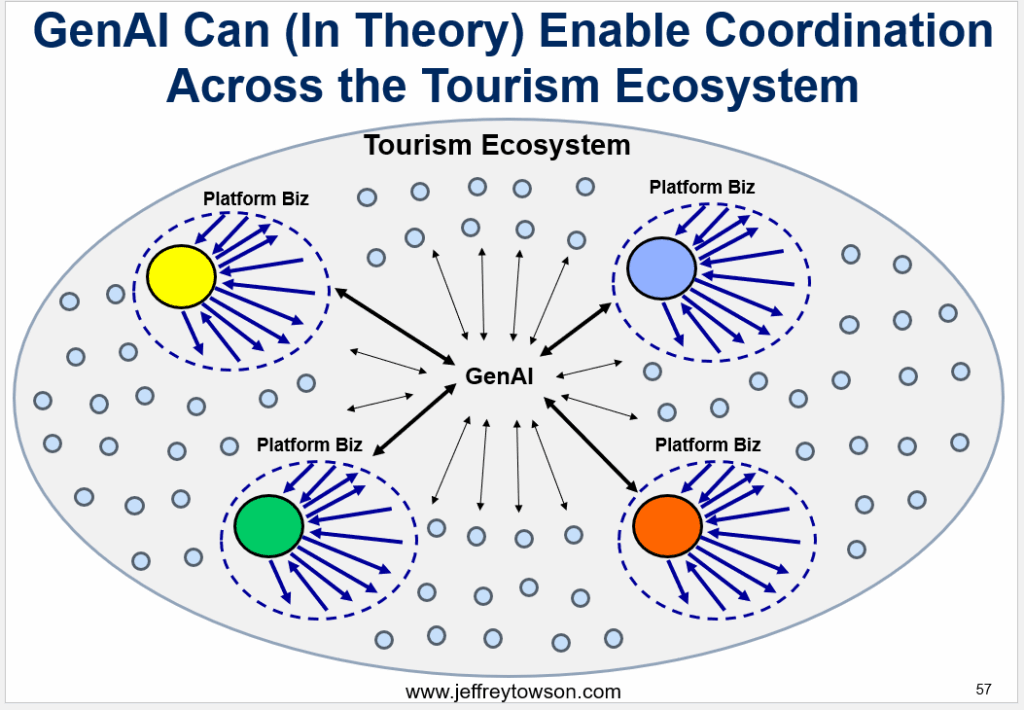
This is the graphic I am thinking about.
Another example Sangeet gives is for a construction project. Like for a large office building. Building such a facility would involve:
- An architecture group. They have unique skills. They have their specialized digital tools like CAD(?). And they have ways of communicating with their clients and amongst themselves. They have specialized forms of data and records. They have well-developed workflows.
- A construction business. They have their own ways of mapping out a project. They have specific processes for managing costs and tasks. That have their own terminology and ways of coordinating internally.
- An interior design team. They have different skills. They talk about what furniture and colors. What lighting and art.
- Electrical and other infrastructure groups. They deal with the electrical and plumbing systems. The sewer systems. The EVAC system. And so on.
- Sales and marketing teams. These people sell the project to clients (ownership and rental). Lots of marketing. Lots of sales activities.
That’s a bad summary of a construction project but you get the point. All these different types of teams have to work together to create one cohesive project. And while they all have ways of coordinating internally, they have very different skills, workflows and systems.
In theory, an AI coordination engine can coordinate all these teams in the office building project. It can listen to all the meetings and can capture all the expertise and tacit knowledge of each specialized group. It can collect all the different types of data (as each group uses different formats) and create a common representative. It can capture all the unstructured data as well. And it can coordinate all the workflows, decisions and execution.
What does that look like in practice?
I think it is easy to see how that will play out at the project level. Far greater productivity. Like with the shipping containers.
But how is this going to change the organizations?
Isn’t this going to change what is done internal vs. external to a firm?
What new business models is such coordination going to enable? Aren’t we going to see entirely new ways of working?
Keep in mind, we didn’t really have multinationals until telephones enabled long-distance communication. And we didn’t really have armies of gig freelancers until platforms like Upwork enabled that type of work. So, what are future construction and design firms even going to look like?
This is the second order cascade that was mentioned. Did anyone really see global trade coming?
One final thought on this point.
Seven years ago, McKinsey made an interesting prediction that the entire business world would consolidate to 8-10 ecosystems. These ecosystems would integrate all the physical and digital activities in certain areas. And these ecosystems would wipe out traditional industry barriers. Here is their graphic from that article.
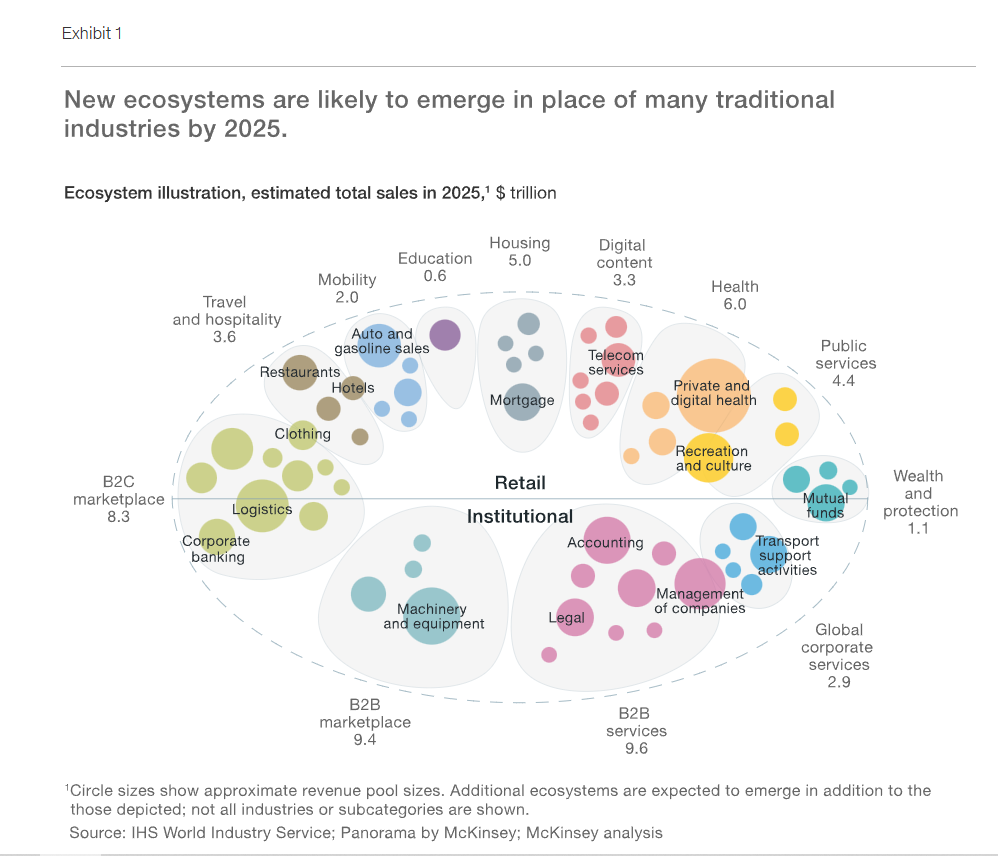
This looks to me a lot like that Tourism Ecosystem graphic I put earlier. I think GenAI might be the key to making this happen.
***
Ok. that’s it for Part 1. In Part 2, I’ll go through one more important take-away from the book.
-Jeff
——–
Related articles:
- How Alibaba.com Re-Ignited Growth with the Alibaba Management Playbook (Tech Strategy – Podcast 253)
- How Amap Beat Baidu Maps. My Summary of the Alibaba Playbook. (Tech Strategy – Podcast 252)
- Scale Advantages Are Key. But Competitive Advantages Are More Specific and Measurable. (Tech Strategy)
From the Concept Library, concepts for this article are:
- GenAI
- Coordination and Transaction Costs
From the Company Library, companies for this article are:
- n/a
———-
I am a consultant and keynote speaker on how to accelerate growth with improving customer experiences (CX) and digital moats.
I am a partner at TechMoat Consulting, a consulting firm specialized in how to increase growth with improved customer experiences (CX), personalization and other types of customer value. Get in touch here.
I am also author of the Moats and Marathons book series, a framework for building and measuring competitive advantages in digital businesses.
This content (articles, podcasts, website info) is not investment, legal or tax advice. The information and opinions from me and any guests may be incorrect. The numbers and information may be wrong. The views expressed may no longer be relevant or accurate. This is not investment advice. Investing is risky. Do your own research.
